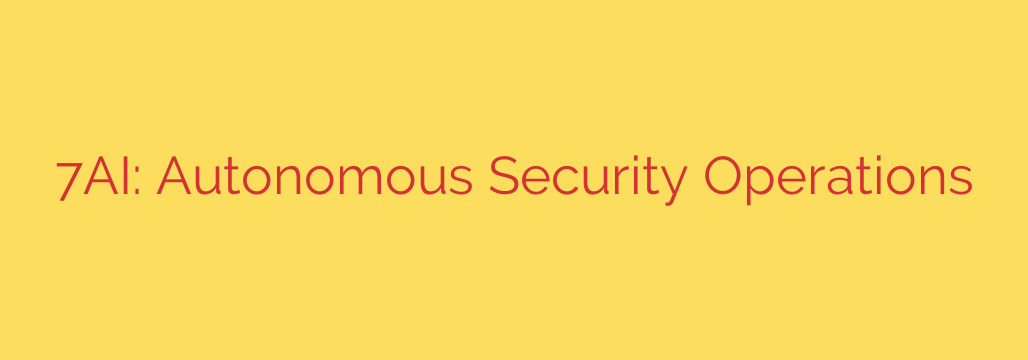
Beyond Automation: Why Autonomous Security is the Future of Your SOC
In today’s hyper-connected world, security teams are facing an unprecedented challenge. The volume of data is exploding, the number of alerts is overwhelming, and sophisticated cyber threats are evolving at a blistering pace. The traditional Security Operations Center (SOC) model, reliant on manual analysis and human intervention, is struggling to keep up. This has led to a critical state of “alert fatigue” and analyst burnout, where real threats can easily get lost in the noise.
The solution isn’t just about working harder or hiring more people; it’s about working smarter. The next evolutionary step in cybersecurity is here: autonomous security operations. This new paradigm promises to transform how we defend our digital assets, moving from a reactive posture to a proactive and intelligent defense.
The Cracks in Traditional Security
For years, the standard approach has been to collect logs and alerts from various tools, funneling them into a SIEM (Security Information and Event Management) system for human analysts to investigate. This model is now at its breaking point for several key reasons:
- Massive Scale: The sheer volume of alerts generated by modern security tools is too much for any human team to handle effectively.
- Speed of Attacks: Automated attacks can compromise a system in minutes, while manual investigation and response can take hours or even days.
- The Skills Gap: There is a persistent global shortage of skilled cybersecurity professionals, making it difficult to staff a 24/7 SOC.
- High Rate of False Positives: Analysts spend a significant portion of their day chasing down alerts that turn out to be benign, wasting valuable time and resources.
Traditional SOC models are simply no longer sustainable in the face of the speed and scale of modern cyber threats. Simply adding more tools or more analysts only adds complexity without addressing the fundamental problem.
What Exactly is Autonomous Security?
It’s crucial to distinguish between automation and autonomy. Automation is about executing a pre-defined script or playbook. For example, automating the process of blocking a known malicious IP address.
Autonomous security, on the other hand, leverages artificial intelligence to independently detect, investigate, and respond to threats with minimal human intervention. Think of it like the difference between a car’s cruise control (automation) and a true self-driving vehicle (autonomy). An autonomous security platform doesn’t just follow orders; it perceives its environment, analyzes complex data sets, makes decisions, and takes action on its own.
An autonomous system can perform complex tasks that were once the exclusive domain of senior security analysts, such as:
- Correlating alerts from dozens of different security tools.
- Conducting deep-dive investigations into suspicious activity.
- Identifying the root cause and full scope of an attack.
- Executing a coordinated response across multiple systems (e.g., isolating a host, disabling a user account, and blocking a domain).
The Core Benefits of an Autonomous Security Platform
Adopting an autonomous approach to security operations delivers transformative benefits that directly address the shortcomings of the traditional model.
Unmatched Speed and Efficiency
An autonomous platform operates at machine speed, 24/7. This drastically reduces the Mean Time to Detect (MTTD) and Mean Time to Respond (MTTR) from hours or days to mere minutes or seconds. By instantly containing threats, you can significantly limit the potential damage and impact of a breach.Superior Accuracy and Threat Prioritization
Advanced AI and machine learning algorithms are exceptionally good at finding the signal in the noise. Autonomous systems can accurately correlate weak signals from multiple sources to identify complex, stealthy attacks that a human analyst might miss. This dramatically reduces false positives and ensures that your human experts are only alerted to high-fidelity, verified threats that truly require their attention.A Force Multiplier for Your Team
Instead of replacing human analysts, an autonomous platform empowers them. It handles the repetitive, time-consuming work of initial triage and investigation, freeing up your skilled personnel to focus on higher-value tasks. This includes strategic threat hunting, architectural improvements, and developing long-term security strategy, which ultimately boosts morale and reduces burnout.Proactive and Predictive Defense
The most advanced autonomous systems don’t just react to threats—they learn and adapt. By continuously analyzing your environment and global threat intelligence, these platforms can predict likely attack paths and proactively recommend or implement hardening measures to strengthen your security posture before an attack even occurs.
Actionable Steps to Embrace Autonomy
Transitioning to an autonomous security model is a journey, not an overnight switch. Here are some practical steps to get started:
- Assess Your Current Operations: Identify your biggest pain points. Are you drowning in alerts? Is your response time too slow? Understanding your specific challenges will help you prioritize where to apply autonomy first.
- Start with Targeted Automation: Begin by automating high-volume, low-risk tasks to build confidence and free up analyst time. This could include ticket enrichment or blocking indicators from trusted threat feeds.
- Invest in AI-Powered Tools: Look for security solutions that are built on a foundation of AI and machine learning. Prioritize platforms that offer robust data correlation and integrated response capabilities.
- Establish Trust and Guardrails: Define clear rules of engagement for any autonomous actions. Start with a “human-in-the-loop” approach, where the system recommends actions for human approval. As you build trust in the platform’s decisions, you can gradually move to a more fully autonomous model for certain types of threats.
The future of cybersecurity lies in harnessing the power of AI to build a resilient, adaptive, and autonomous defense. By embracing this shift, organizations can not only survive the modern threat landscape but thrive in it, ensuring their most critical assets are protected around the clock.
Source: https://www.helpnetsecurity.com/2025/08/06/7ai-enables-end-to-end-autonomous-security-operations/








